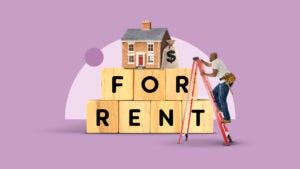How to get a home equity loan with bad credit

Key takeaways
- A lower credit score doesn’t necessarily mean a lender will deny you a home equity loan. It does mean the loan will be more expensive, as you won’t get the lowest interest rate.
- It’s possible to get a home equity loan with a fair credit score — as low as 620 — as long as other requirements around debt, equity and income are met.
- Strategies for getting a loan despite your bad credit include taking on a co-signer, applying to a place where you currently bank, and writing a letter of explanation to the lender.
- Alternatives to a home equity loan include personal loans, cash-out refinances, reverse mortgages and shared equity agreements.
Can you get a home equity loan with bad credit?
Yes, you can. A lower credit score doesn’t necessarily mean a lender will deny you a home equity loan. Some home equity lenders allow for FICO scores in the “fair” range (the lower 600s) as long as you meet other requirements around debt, equity and income.
That’s not to say it’ll be easy: Lenders tend to be stringent with these loans even more so than they are with mortgages. Still, it’s not impossible. Here’s how to get a home equity loan (even) with bad credit.
Requirements for home equity loans
Not all home equity lenders have the exact same borrowing criteria, of course. Still, general guidelines do exist. Typical requirements for home equity loan applicants include:
- A minimum credit score of 640
- At least 15 percent to 20 percent equity in your home
- A maximum debt-to-income (DTI) ratio of 43 percent, or up to 50 percent in some cases
- On-time mortgage payment history
- Stable employment and income
To learn a specific lender’s requirements for a home equity loan, you’ll need to do some research online or contact a loan officer directly. If you aren’t ready to apply for the loan just yet, ask for a no-credit check prequalification to avoid having the loan inquiry affect your credit score.
What are “good” and “bad” scores for home equity loans?
First, let’s define our terms. Here’s how FICO — the most popular credit scoring model — categorizes different scores:
Score |
Classification |
|---|---|
| 300-579 | Poor |
| 580-669 | Fair |
| 670-739 | Good |
| 740-799 | Very Good |
| 800-850 | Excellent |
| Source: MyFico.com | |
When it comes to home equity loans, lenders set a high bar for creditworthiness — higher, even, than mortgages. That’s because they are considered riskier than mortgages: You, the applicant, are already carrying a big debt load. Should you default and your home get seized, the home equity loan — as a “second lien” — only gets paid after the primary (the original) mortgage.
Furthermore, home equity loans don’t have a robust secondary market they can be sold on, like most mortgages do. So the lender usually bears all the risk of originating and then keeping them.
As a result, home equity lenders set stricter criteria, demanding scores squarely in the “fair” range. A score in the 500s – good enough for an FHA mortgage — will have a tough time qualifying for a home equity loan. Some lenders have loosened their standards of late and are approving applicants with scores as low as 620. But a “good” score, preferably above 700, remains the threshold for many institutions. It can vary even within one lender, depending on factors like the loan amount or other loan terms.
And of course — as with any loan — the lower your credit score, the less likely you will qualify for the best interest rates.
How to apply for a bad credit home equity loan
Before applying for a home equity loan, remember that it’s not just a question of getting the financing, but also how you can overcome a lower credit score to get the best possible rate. Here are some steps to take:
1. Check your credit report
Check your credit reports at AnnualCreditReport.com to get a sense of where you stand. If there are any errors, like incorrect contact information, contact the credit bureau — Equifax, Experian or TransUnion — to get it updated as soon as possible.
2. Determine your equity level
To qualify for a home equity loan, lenders typically require that you own at least 15 percent or 20 percent of the home outright. The amount of equity you have, your home’s appraised value and your combined loan-to-value (CLTV) ratio help determine how much you can borrow.

Home equity loan calculator
Bankrate’s home equity loan calculator can estimate your potential home equity loan amount.
Visit the calculatorHere’s a quick way to calculate your equity: Take the value of your home and subtract the balance left on your mortgage. While lenders will only consider the official appraised value of your home when determining how much you can borrow, you can get an idea of your home’s value through Bankrate or a real estate listing portal or brokerage.
Let’s say your home is worth $420,000 and you have $250,000 to pay on your mortgage:
$420,000 – $250,000 = $170,000
In this example, you’d have $170,000 in home equity.
That doesn’t mean you can borrow $170,000, however. If the lender requires you to maintain at least 20 percent equity, you’d need to preserve $84,000 ($420,000 * 0.20). That leaves you with the potential to take out a home equity loan of up to $86,000 ($170,000 – $84,000).
Remember: When taking out the loan, make sure your combined loan-to-value (CLTV) ratio — the total of all your home-based debt — is within the lender’s limit, typically 80 percent or lower.
3. Find out your DTI ratio
The DTI ratio is a measure lenders use to determine whether you can reasonably afford to take on more debt. To calculate your DTI ratio, simply divide your monthly debt payments by your gross monthly income. For example, say you bring in $6,000 a month in income and have a $2,200 monthly mortgage payment and a $110 monthly student loan payment:
$2,310 / $6,000 x 100 = 38.5%
To make things even easier, you can use Bankrate’s DTI calculator.
For a home equity loan, most lenders look for a DTI ratio of no more than 43 percent.
4. Consider a co-signer
If your credit score is making it tough for you to get a home equity loan, taking on a co-signer with better credit might score you an approval.
A co-signer is just as responsible for repaying the loan as the primary borrower, even if they don’t actually intend to make payments. If you fall behind on loan payments, their credit suffers along with yours.
The extra guarantee they provide might get you over the hump if your credit is iffy. But you still have to basically qualify on your own. “A co-signer can help with credit and income issues for an applicant who has a lower credit score, but ultimately the main applicant or primary borrower will have to have at least the bare minimum credit score that is required based on the bank’s underwriting guidelines,” says Ralph DiBugnara, president of Home Qualified, a real estate platform for buyers, sellers and investors.
5. Try a lender you already work with
If your bank, credit union or mortgage lender offers home equity products, it might be able to extend some flexibility, or at least help with your application, since you’re an existing customer.
“A loan officer familiar with the details of an applicant’s situation can help them present it to an underwriter in the best possible way,” says DiBugnara.
6. Write a letter to the lender
Write a letter of explanation describing why your credit score is low, especially if it has taken a recent hit. This letter should matter-of-factly explain credit issues — avoid catastrophizing — and include any relevant paperwork, like bankruptcy documentation. If your credit score was impacted by late payments due to job loss, for example, but you’re employed now, your lender can take this context into consideration.
Lenders that offer home equity loans with bad credit
There are home equity lenders that offer loans to borrowers with lower credit scores. (See FAQ, below). Here are some to consider, along with their requirements:
| Lender | Bankrate Score (scale of 1-5) | Loan types | Credit score minimum | Maximum CLTV | Maximum DTI |
|---|---|---|---|---|---|
| Figure | 4.2 | HELOC | 640 | 75%-90% | Undisclosed |
| Rate | 4.1 | HELOC | 620 | 90%-95% | 50% |
| Spring EQ | 4.1 | Home equity loan, HELOC | 640 for home equity loans, 660 for HELOCs | 90% | 43% |
| TD Bank | 3.8 | Home equity loan, HELOC | 660 | 90% | Undisclosed |
| Connexus Credit Union | 4.2 | Home equity loan, HELOC | 640 | 90% | Undisclosed |
| Discover | 4.0 | Home equity loan | 660 | 90% | 43% |
Pros and cons of getting a home equity loan with bad credit
Getting a home equity loan with bad credit has its benefits and drawbacks. You can tap your equity to help with expenses, but it’s also risky.
Pros
- Access to funds: A home equity loan gives you a significant amount of cash at your fingertips, which can help you pay for home improvement projects, consolidate high-interest debt and tackle big-ticket expenses.
- You’ll pay a fixed rate: Home equity loans are for a fixed sum at a fixed interest rate, so you’ll know exactly how much your payment is each month. This can help you budget for and reliably pay down debt, which can help boost your credit score.
- You could get out of costlier debt: If you have high-interest debt — like credit card debt — you could pay it off with a lower-rate home equity loan, then repay that loan, with one payment, for less.
Cons
- You’re taking on more debt: If you’ve had trouble managing money in the past, it might not be wise to take on more debt with a home equity loan, even if you qualify.
- It’ll be more expensive: A lower credit score won’t qualify you for the best home equity loan rates, meaning you’ll pay more in interest.
- You could lose your home: If you fall behind on loan payments, you’ll further damage your credit. Even worse: If you’re eventually unable to pay back the loan, your home could go into foreclosure.
What to do if your home equity loan application is denied
If your application for a home equity loan is rejected, don’t despair. First, ask the lender for specific reasons why your application was denied. The answer can help you address any issues before applying in the future.
If your credit was one of the deciding factors, you can improve your score by making on-time payments and paying down any outstanding debt. If you don’t have enough equity in your home, wait until you’ve built a bigger stake (mainly by making your monthly mortgage payments) before submitting a new application.
Both these approaches may take a half-year to a year to make a significant difference in your credit profile. If you’re in more of a hurry, consider applying to other lenders, as their criteria may differ. Just bear in mind that more lenient terms often mean higher interest rates or fees.
And of course, you can consider other forms of financing.
Home equity loan alternatives if you have bad credit
If you need cash but have bad credit, a home equity loan is just one option. Here are some alternatives:
Personal loans
Personal loans can be easier to qualify for than a home equity product, and they aren’t tied to your home. Personal loans have higher interest rates, however, and shorter repayment terms. This translates to a more expensive monthly payment compared to what you might get with a home equity loan.
Cash-out refinance
In a cash-out refinance, you take out a brand-new mortgage for more than what you owe on your existing mortgage, pay off the existing loan and take the difference in cash. Most lenders require you to maintain at least 20 percent equity in your home in order to cash out.
A caveat, however: A cash-out refi makes the most sense when you can qualify for a lower rate than your current mortgage’s, and if you can afford the closing costs. With bad credit, getting that lower rate might not be possible.
Reverse mortgage
Reverse mortgages allow homeowners over the age of 62 to tap their home’s equity as a source of tax-free income. These types of loans need to be repaid upon your death or when you move out or sell the home. You can use reverse mortgages for anything from medical expenses to home renovations, but you must meet some requirements to qualify.
Shared equity agreement
Home equity investment companies might work with you even if you have a lower credit score, often lower than what traditional lenders would accept. These companies offer shared equity agreements in which you receive a lump sum in exchange for an ownership percentage in your home and/or its appreciation.
Unlike with home equity lines of credit (HELOCs) or home equity loans, you don’t make monthly repayments in a shared equity arrangement. Some companies wait until you sell your home, then collect what they’re owed; others have multi-year agreements in which you’ll pay the balance in full at the end of a stated period.
Make sure you understand all the terms of this complex arrangement. Technically, you’re not borrowing money, you’re selling a stake in your home — to a financial professional who naturally wants to see a return on their investment.
How to get a HELOC with bad credit
Applying for a HELOC is pretty much the same as applying for a home equity loan, but if you have bad credit, a loan might have a slight edge over the line of credit. That’s because home equity loans have fixed interest rates and fixed payments, so you’ll know exactly what you need to repay each month. This predictability could help you better manage your budget and keep up with payments.
A HELOC, on the other hand, has a variable rate, which can cause unexpected increases in your monthly payments. For this reason, lenders often have higher credit score criteria for HELOCs than home equity loans.
Tips for improving your credit before getting a home equity loan
To increase your chances of getting approved for a home equity loan, work on improving your credit score well before applying — at least several months. Here are three tips to help you rebuild your credit:
- Pay bills on time every month. At the very least, make the minimum payment, but try to pay the balance off completely, if possible — and don’t miss that due date.
- Don’t close credit cards after you pay them off. Either leave them open or charge just enough to have a small, recurring payment every month. Closing a card reduces your credit utilization ratio (CUR), which can decrease your score. The recommended CUR: no more than 30 percent.
- Be cautious with new credit. Getting a higher credit limit on a card or getting a new card can lower your credit utilization ratio — but not if you immediately max things out or blow through the bigger balance. Treat the newly available funds as sacred savings.
FAQ on getting a home equity loan with bad credit
Additional reporting by Mia Taylor
You may also like

How to fix your credit score to buy a house

How to get a business loan with bad credit

Best home equity lenders for bad credit in 2025



